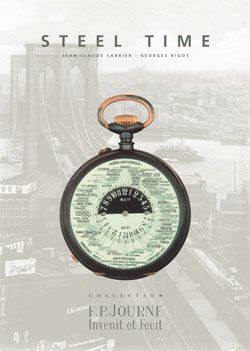F.P. Journe presents an avant premier exhibition devoted to steel and horology. The event is open to the public at the F. P. Journe manufacture in its new exhibition centre at 17, rue Arquebuse, Geneva. Open untiil December 21st 2007. There is also a book to accompany the show.
The industry of laminated iron was one of the great adventures of the 19th century. Produced in large quantities as of 1845, the material was used in railways, bridges, towers, and innovative buildings. The fashion spread to all walks of life, and not the least horology!

The exceptional collection shown in the exhibition and the book was assembled by an enthusiastic collector. For over 20 years, this patient and knowledgeable collector sought out and acquired more than 220 watches, each with its own particular fascination and character. The illustrations in sepia are not part of the collection ; they represent watches of historical or stylistic importance.
Montres Journe S.A. is privileged to be the guardian of this collection, and has chosen to devote a book to it, written by today’s most notable experts.
Their lively study shows how these watches, though they share the common denominator of gunmetal cases, in fact demonstrate a wide variety of styles and techniques that prefigure the wristwatch. The authors describe the techniques employed in the creation of these “everyman’s” watches, tracing some of their history as far back as the 17th century. They
paint a captivating picture of a new type of watch that was both egalitarian and - fun! Rarely has such playfulness been seen in horology, and almost never in the field of “high quality” watches.
Steel has generally been employed in horology for its low cost. I take this occasion to present the only F. P. Journe watch with a steel case. This watch, paradoxically the most expensive of my collection, is a technically demanding “Grande Sonnerie”. Five years were required for its development and its innovations resulted in no fewer than ten patents.
This exceptional watch is housed in a steel case, simply because steel - which unlike platinum is crystalline in structure - is a better conductor of sound, and the case, in order to be watertight, can have no openings. Steel is thus used for its physical and mechanical qualities. Like all F. P. Journe watches, the movement’s plate and bridges are made exclusively of 18 carat pink gold.
The watches revealed in this book are part of a common heritage. Rather than keeping them hidden, I have chosen to show them to the public. It is my modest hope that those who are inspired by them for their future creations will give to Caesar what belongs to him.
Preface of François-Paul Journe
The book is available in English, French and Italian.
Source: F.P. Journe
www.fpjourne.com
Contact:[email protected]
(Please credit europastar.com)





